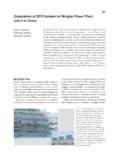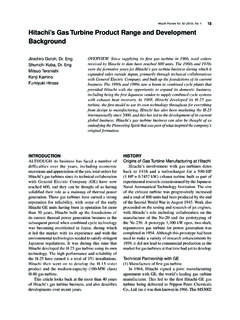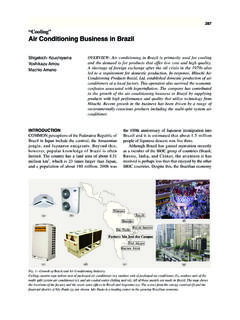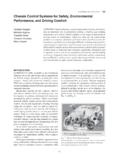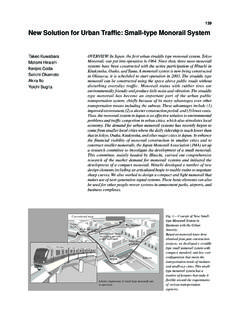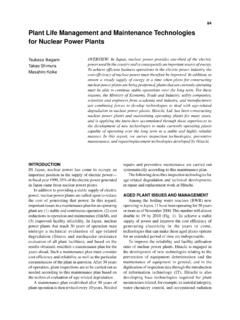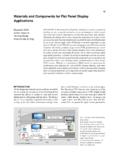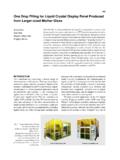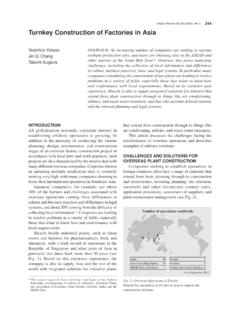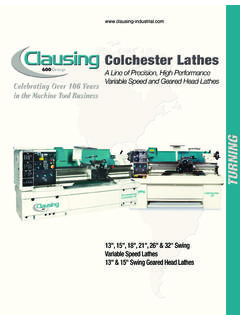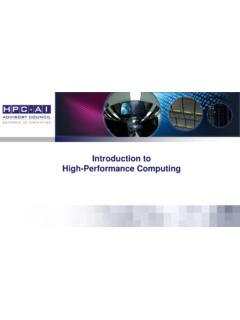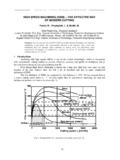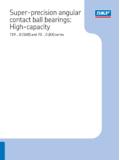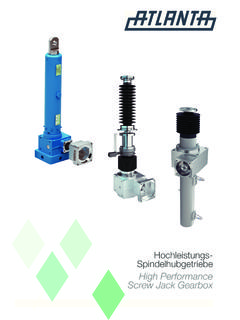Transcription of High-performance Printed Circuit Board Production ...
1 High-performance Printed Circuit Board Production Equipment for Ultra- high Density Multi-layer Wiring 216 High-performance Printed Circuit Board Production Equipment for Ultra- high Density Multi-layer WiringNorio MichigamiMasatoshi YamagaMasahiro KawamuraOsamu KuzeShigeo NakamuraINTRODUCTIONTHE trend toward producing PCBs ( Printed Circuit boards) with higher densities as electronic products have become more sophisticated is driving demand for smaller diameters and higher precision in the machining of interlayer connection holes on PCBs by mechanical and laser drilling the Circuit patterns produced by the OVERVIEW: Recent years have seen dramatic progress in the performance of electronic devices such as mobile phones, notebook PCs, and electronic books.
2 These performance improvements require not only the miniaturization and performance enhancement of the semiconductors and other components used in these devices but also the ability to achieve higher densities, multi-layer structures, and smaller hole diameters in the PCBs on which these components are mounted to form electronic circuits. As a manufacturer of Production machinery for PCBs, Hitachi Via Mechanics, Ltd. supplies mechanical and laser drilling machines able to drill small-diameter interlayer connection holes with high speed and precision and direct exposure machines capable of producing the very fine wiring and high precision needed for higher wiring densities. These machines are supplied to the PCB industry throughout the world where they contribute to improvements in the performance of electronic performance improvement(1) Higher precision(2) Smaller diameters, finer line dimensions(3) Higher speedMechanical drilling machineLaser drilling machineDirect exposure machineThrough holeBlind holeDry filmexposure sampleThrough holeBlind holeMobile phoneNotebook PCDigital cameraSemiconductor packageCircuit (wiring) high -density PWBsCross-section of high -density multi-layer PWBT hrough hole:Blind hole: Circuit pattern writing.
3 Mechanical drilling machineLaser drilling machineDirect exposure machinePrinted wiring boards with smaller hole diameters and higher precision(1) Smaller conductor widths (higher precision)(2) Smaller diameter through holes, larger numbers of holes(3) Multi-layerLighter electronic devices with higher performanceFig. 1 Role of Drilling Machines and Exposure Machines in Printed Wiring Board and laser drilling machines are used to machine interlayer connection holes on multi-layer Printed wiring boards and direct exposure machines are used for Circuit pattern : Printed wiring Board PC: personal computerHitachi Review Vol. 60 (2011), No. 5 217 Circuit forming process are becoming ever finer and this creates a need for smaller inter-wire spacings and greater precision in through hole and pad alignment article describes the trends in hole machining technology using drills and lasers able to produce PCBs with higher densities, and in ultra-fine, high -precision exposure technology using direct exposure IN Printed Circuit BOARDS AND Production EQUIPMENTRole of Drilling and Direct Exposure MachinesThe need for high -density mounting on PCBs has made the build-up Printed wiring Board an essential technology.
4 Similarly, the machining of THs (through holes) using drills and BHs (blind holes) using lasers are both important techniques for making connection holes during mass Production . Meanwhile, Circuit pattern formation is starting to shift away from the mask exposure technique used in the past toward direct exposure which can draw the circuitry directly using fine lines (see Fig. 1).Technologies for Higher DensityThe demand for PCBs with higher densities is also accompanied by a need for higher precision, smaller diameters, finer lines, and faster speeds. To achieve these requirements, Hitachi Via Mechanics, Ltd. is adopting high -speed spindles [350,000 rpm (revolutions per minute)] and table servo technology with high speed and precision for mechanical drilling machines, galvano technology using panels and multiple beams with high speed and precision (> 3,000 Hz positioning) for laser drilling machines, and small high -precision lenses and high -speed data processing techniques ( Gbyte/s) for direct exposure machines.
5 The following sections describe the technologies used for each type of machine (see Fig. 2).DRILLING TECHNOLOGYPCBs can be divided into single-sided, double-sided, and multi-layer boards depending on the application, and the higher mounting densities associated with making products smaller and more sophisticated have led to drill hole diameters being reduced to mm or less for various different device types including PCs (personal computers) and mobile phones. Recent years have also seen a shift toward use of FC-BGA (flip chip ball grid array) and CSP (chip-size package) packages which has led to drill hole diameters as small as is anticipated that hole diameters of mm or smaller will be required in future (see Table 1).
6 high -speed SpindleThe spindle is the rotating part that holds the drill bit and is a critical component for small-diameter drilling. Current practice aims to achieve higher Through holemachining (drill)Blind holemachining (laser) Circuit patternformation(direct writing)Diameter: to mmPWBPWBDMDL ensesLightsourcePWB(panel)Table(350,000 rpm)DrillGalvanoLaseroscillatorDiameter: to mmLine/space: min. 8 m(Technologies for achieving higher densities) Ultra- high -speed spindle(air bearings, high -frequency motor) high -precision table servo(Technologies for achieving higher densities) Multiple panels and beams high speed, high -precision galvano(> 3,000 Hz positioning)(Technologies for achieving higher densities) Small high -precision lenses high -speed data processing techniques( Gbyte/s)f lens Fig.
7 2 Drilling and Exposure Machine Technologies for Achieving Higher processing capacities of different machines and the technologies they use to achieve higher densities are : revolutions per minute DMD: digital micro-mirror deviceApplicationHole diameter (mm)Hole positioning accuracy (mm)PCs, notebook PCs < phones < cameras, games < < or less(< )TABLE 1. Drill Hole Diameters for Different PCB ApplicationsDrill hole diameters and hole positioning accuracy for different PCB ( Printed Circuit Board ) applications (products) are : flip chip ball grid array CSP: chip-size packageFig. 3 Spindle internal structure of a high -speed spindle with air bearings is jawAir bearingsStator coilCollet chuckHigh- performance Printed Circuit Board Production Equipment for Ultra- high Density Multi-layer Wiring 218 spindle speeds as well as smaller diameters, with machining of holes being performed at a (maximum) speed of 350,000 min-1.
8 To cope with these high speeds, the spindles use air bearings and a direct drill bit held by a precision collet chuck built into the rotor. The system also requires technology for stable high -speed rotation that can keep the dynamic vibration of the drill bit tip to within 10 m. The development of ultra- high -speed spindles able to operate above 350,000 rpm is an important challenge for achieving reliable machining of hole diameters in future (see Fig. 3).Hole Position AccuracyThe smaller hole diameters needed to increase the density of PCBs require more accurate positioning of where the holes are machined (see Table 1). Achieving this high -precision machining using a conventional six-drill drilling machine requires servo technology able to position, in 50 ms or less, a large (approximately 500 kg) table on which Circuit boards are placed at six stations.
9 Recently, Hitachi Via Mechanics has devised a new system in which the vibration caused by the movement of this large mass can be reduced by splitting the table and spindle units into two three-drill units so that the left and right halves can move in mutually opposing directions to damp vibration, as shown in Fig. 4. This is complemented by a new type of drilling machine with higher precision. For the Z-axis, the machine uses a tunnel actuator type linear motor jointly developed with Hitachi Research Laboratory which moves the spindle up and down at a rate of more than 800 hits per minute. An indication of the hole position accuracy required in practice is that future CSP components with a hole diameter will require an accuracy of mm or less (see Fig.)
10 5).Technologies for high -speed DrillingHigher PCB density means more holes to be drilled. Whereas the 500 600-mm boards used in the Production of mobile phones typically require 30,000 to 50,000 holes, for a CSP Board this number rises to 200,000 to 300,000. With some boards requiring as many as one million holes, higher drilling speeds have become essential. The drilling process involves positioning the Board in the XY axes and the vertical movement of the drill in the Z axis. Because hole pitches are becoming smaller, the benefits of faster XY-axis movement are limited and instead speed improvement requires a shorter Z-axis stroke and faster Z-axis feed rate. However, with the Z-axis feed rate being determined by the drill diameter, spindle speed, and Board material making it highly dependent on increases in the spindle speed, minimizing the Z-axis stroke is essential.
